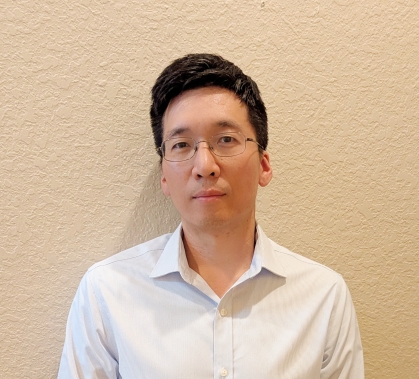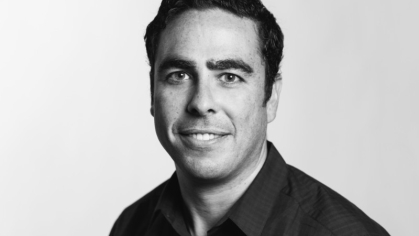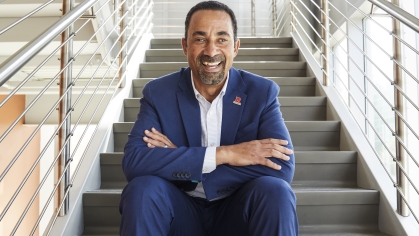
After graduating with degrees in mechanical engineering and computer science, J.J. Slade Scholar and Unisys Scholar JB Kim worked as a Unix engineer at Deutsche Bank before spending nearly ten years at Morgan Stanley as a quantitative developer, quantitative trader, and researcher. Before recently founding his Florida-based trading company, nVersus Capital, he was a team lead and quant trader at a privately held trading firm. He recently created an endowment fund to support an inaugural cohort of student interns at Rutgers Wireless Information Network Laboratory, or WINLAB.
“Rutgers engineering prepared me to continue to learn and that’s what I’ve tried to do.” - JB Kim
Where did you grow up?
I was born in Korea and came to the states when I was 10 years old. I went to high school in Ridgewood. I’m a Jersey boy through and through.
Why Rutgers?
Rutgers was close to home, and while I had opportunities to go to other schools, the word from my high school teachers was it was the best value for the money. As a large institution, I had access to a variety of resources and the flexibility to try different majors.
Why did you choose mechanical engineering and computer science?
In the early 2000s, the dotcom bubble was huge, and was attracting students and faculty to computer science, where the career prospects were high. Mechanical engineering was rigorous, so adding a degree in computer science was certainly easier.
How did you end up on Wall Street?
The irony was that my engineering skillset helped me more compared to computer science in my first job.
By the time I graduated, the dotcom bubble had burst. Now I was stranded – tech companies weren’t hiring. But Wall Street was aggressively hiring engineers as the major investment banks were transitioning to the Linux operating system in the early 2000s.
When I was recruited by Deutsche Bank to help build and maintain their infrastructure, my parents were dumbfounded, wondering what a mechanical engineer was doing at a bank!
How did your mechanical engineering degree help you?
ME distinguished professor Doyle Knight and information technology director Alexei Kotelnikov were involved in cluster computing – doing research with many machines. I was awarded a Unisys scholarship to help build a computational cluster.
This hands-on, practical experience differentiated me on Wall Street. SoE prepared me with a mathematical and engineering mindset, and I looked for areas where I could apply my knowledge using computers. This prepared me to transition my career to quantitative finance.
Why a master’s in statistics?
Emanuel Derman’s book, My Life as a Quant, was inspiring to a nerd like me. I thought I’d found something I really wanted to do. Quant trading uses computing power and engineering. I hadn’t connected them until I read that book.
Towards the end of my program at Columbia, I transitioned into an internal trading team called ETL at Morgan Stanley, that was well known within statistical arbitrage and systematic trading circles.
I was equipped with skills to contribute there, and my career really took off after I joined this team. My only missing pieces were financial and trading concepts, but what I needed to learn, I learned on the job.
Trades were being done automatically through computers. There was no human touch. Humans made mathematical models to trade with. I reveled in this – I was so excited about this I couldn’t sleep. And I arguably excelled at this. I learned how to automate the full stack in systematic trading.
What came next for you?
I read another book – Flash Boys by Michael Lewis, which talks about high-frequency traders. This piqued my interest, and so I ended up working at a big, privately held high-frequency trading firm. I left after seven-and-a-half years to do something I’ve never done before: create my own company.
What I did at the high-frequency trading firm made a bit of splash. One of the largest hedge funds in the world, asked to invest with me – and manage their money. Initially, I wasn’t interested, but the attractiveness of running my own company itched my desire to try. Today, my ten-person team of consultants and full-time investment professionals, collectively known as nVerses Capital, is managing systematic portfolios for an exclusive investor.
What is your endowment funding at Rutgers?
I hope to show incoming students what it’s like to work in industry. If I can help raise the future generation of engineers, I’ll be happy. This is something I’m truly passionate and excited about.
I’ve made a three-year commitment to support and do research projects through WINLAB’s summer internships program. We’ll have an exciting first-year group of 10 to 15 students this summer. WINLAB has asked us to assign mentors within the industry, so we’re getting industry professionals with engineering and science backgrounds to come in and share their knowledge. I will absolutely be there, too.
What do you value most about your Rutgers engineering education?
I was first in my class in ME and gave a speech on graduation day. Afterwards, Dr. Knight said, “You haven’t learned anything. Just remember that engineering has taught you how to learn. So, start now.” I took this advice to heart. Rutgers engineering prepared me to learn a lot more, and that’s what I’ve tried to do.
What advice would you have for today’s students?
Be hungry to learn and share what you learn. The act of sharing what you learn helps you internalize knowledge better and keeps you honest.
What did you like to do for fun when you were a student?
I love K-Pop and I was involved in hip-hop dancing, and hung out with the dance troupe.
What do you do for fun these days?
I’m busy with my four kids, ages 14, 12, 8, and 6.
Where would you go if you were to take a vacation tomorrow?
I’d go to Japan because I love toys. My kids, who grew up watching anime, do too. Exposing them to different cultures or a city like Tokyo would be interesting.


